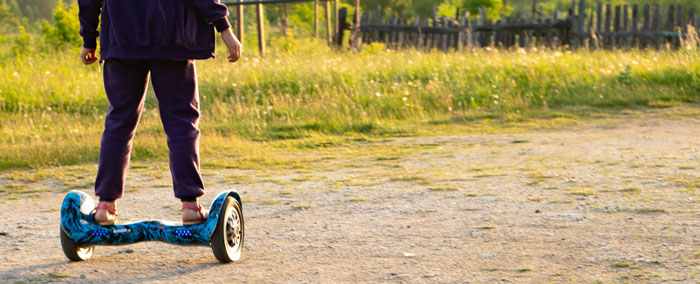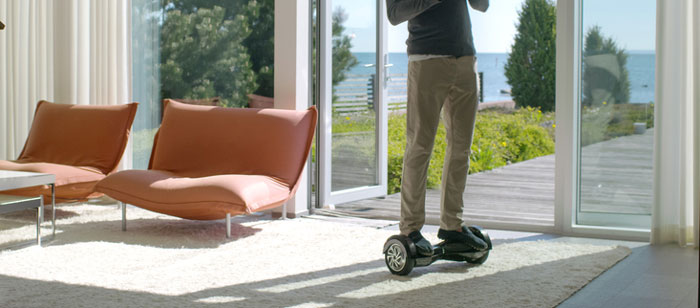In this article, we’ll cover whether you should take your hoverboard outdoors or are they meant to be used indoors only.
Can you use a hoverboard outside?
While hoverboards are intentionally toy-like and attractive by design, with bright LED rims, rainbow lights and often brightly coloured plastic casing, they’re a lot tougher than they appear. Standard hoverboards can actually run perfectly happily on some rough surfaces including grass, bumpy roads or even sand!
We’ll cover this in greater depth in the rest of this article.
Although you’ll have to check the laws where you are…
It’s still technically illegal to ride ‘powered transporters’, including hoverboards, outdoors in public places in the UK. However, no matter how black and white it is on the official .gov website, there’s still a lot of grey area as to whether or not police are enforcing it.
You’re not meant to ride hoverboards in public places but most of us have seen children and adults riding them on paths and in parks.
We have a full hoverboard legal guide here if you’re interested in hopping on your hoverboard and heading out into the world.
Will hoverboards work well on outdoor surfaces?

You don’t need an all-terrain hoverboard for most outdoor uses
In case you didn’t know, off-road hoverboards are a thing. As with the larger Segways, you can get a beefier, tougher version that’s designed to tackle the kinds of surfaces regular hoverboards hate: mud, stones, uneven rugged trails. The tyres are much thicker for starters.
But for regular outdoor use, such as paths, roads and even grass, this might be overkill. Unless you’re specifically wanting to get back to nature and do some serious off-road hoverboarding, you don’t need one of these types of boards.
Standard hoverboards are able to run on grass, pavements and even roads that aren’t perfectly flat. They have been known to have issues crossing larger cracks though so take care of those.
Check out this video to see a standard hoverboard in action on some different kinds of surfaces in Nigeria, where the roads are notoriously bumpy and uneven. As you can see, this is not an off-road hoverboard and it copes extremely well with the bumps, rocks and other debris in the road.
Will using my hoverboard outdoors shorten its life or damage the tyres?
So long as you avoid water and don’t drive through anything dodgy, such as broken glass, your hoverboard will be fine. It’s highly likely your hoverboard will have solid tyres that are impossible to ‘pop’ anyway, so even if the worst happens you won’t have to walk home.
Are all hoverboards waterproof?
One thing we need to talk about in the UK is how the weather will affect or harm your hoverboard. Let’s face it, there’s plenty of rain in our part of the world. This is one area where regular everyday hoverboards can’t be used outside.
Here’s the bottom line: most hoverboards are not happy getting wet!
Water can easily get into the casing and wreak havoc with the internal electricals, causing serious damage to your hoverboard.
Avoid riding on wet surfaces with your hoverboard
It’s also worth noting that riding on wet roads can be just as harmful to your hoverboard. Water can easily get inside the board without even going through a puddle. The tyres pull water from the ground as they turn and it finds its way in through the casing.
You can buy waterproof hoverboards but unless the description or manual specifically says that your model is waterproofed, err on the side of caution and avoid riding when it’s wet.
If you’re worried about getting your board wet when you’re out and about, you can get some really decent (and cheap) waterproof bags so, if you’re caught in a sudden downpour, you can slip your board in there for protection.
Is it better to use hoverboards indoors?

Legal requirements are taken into consideration and bad weather avoided, there’s no reason not to ride outdoors on your hoverboard.
The only exception is if you’re new to riding one and are still at the wobbly phase, you might want to delay that trip outdoors and practice in the safety of your home until you get the hang of it.
As we mentioned in our how to get on and off a hoverboard guide, a lot of people feel more comfortable learning in a room with a carpet to cushion the fall and a sturdy table lean on. Although grass can be just as safe to practice on should you fall.
What are the drawbacks to using your hoverboard indoors?
Rough surfaces can drain the battery faster
The more work a hoverboard has to do, the more power it requires and the quicker you’ll run out of charge. Not all homes have especially thick carpets but if you do, it will drain your battery that bit faster.
Will using a hoverboard indoors harm my floors?
When any kind of rubber slides around on polished wooden floors, there’s a chance you’ll end up with a black mark. Having said that, a hoverboard isn’t going to completely ruin your natural wood floors and any marks are generally easy to rub off.
As far as carpet goes, so long as your hoverboard’s wheels are clean, there shouldn’t be any marks left on the surface.
You will see some impressions and imprints from the tyres though. If it’s a nice new carpet and you’re looking to keep that fluffy look, maybe take it to another room.
Watch out for that vase!
If you’re new to hoverboards and just learning, they can seem unpredictable and prone to quick movements that can send new rides sprawling. Riding a hoverboard indoors is a lot of fun but you can do some serious damage to your possessions if you’re not careful. This applies more to new users!
Check out some of these examples and make sure you either use your board in a room that has plenty of space or at least clear some of the breakables out of the way before you step on your board. Your TV will thank you later.
Summing up: Taking your board outdoors
Whether you get an off-road hoverboard or one of the hundreds of standard boards that have popped up on places like Amazon in the UK, they will both work perfectly well indoors or outdoors.
Despite their appearance, they’re actually robustly designed and can weather most surfaces. Take care to avoid wet roads and you’ll be fine.